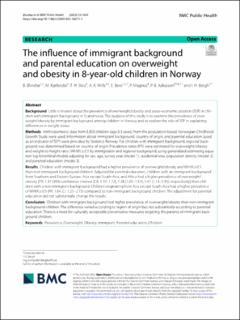| dc.contributor.author | Øvrebø, Bente | |
| dc.contributor.author | Kjøllesdal, Marte Karoline Råberg | |
| dc.contributor.author | Stea, Tonje Holte | |
| dc.contributor.author | Wills, Andrew Keith | |
| dc.contributor.author | Bere, Elling Tufte | |
| dc.contributor.author | Magnus, Per Minor | |
| dc.contributor.author | Juliusson, Pétur Benedikt | |
| dc.contributor.author | Bergh, Ingunn Holden | |
| dc.date.accessioned | 2023-10-03T12:20:14Z | |
| dc.date.available | 2023-10-03T12:20:14Z | |
| dc.date.created | 2023-09-25T10:59:06Z | |
| dc.date.issued | 2023 | |
| dc.identifier.citation | BMC Public Health. 2023, 1-12. | |
| dc.identifier.issn | 1471-2458 | |
| dc.identifier.uri | https://hdl.handle.net/11250/3093792 | |
| dc.description.abstract | Background Little is known about the prevalence of overweight/obesity and socio-economic position (SEP) in children with immigrant background in Scandinavia. The purpose of this study is to examine the prevalence of overweight/obesity by immigrant background among children in Norway and to explore the role of SEP in explaining differences in weight status. Methods Anthropometric data from 8,858 children (age 8.3 years) from the population-based Norwegian Childhood Growth Study were used. Information about immigrant background, country of origin, and parental education (used as an indicator of SEP) were provided by Statistics Norway. For children with immigrant background, regional background was determined based on country of origin. Prevalence ratios (PR) were estimated for overweight/obesity and weight-to-height-ratio (WHtR) ≥ 0.5 by immigration and regional background, using generalized estimating equation log-binominal models adjusting for sex, age, survey year (model 1), residential area, population density (model 2) and parental education (model 3). Results Children with immigrant background had a higher prevalence of overweight/obesity and WHtR ≥ 0.5 than non-immigrant background children. Adjusted for parental education, children with an immigrant background from Southern and Eastern Europe, Asia except South-Asia, and Africa had a higher prevalence of overweight/obesity [PR: 1.37 (95% confidence interval (CI): 1.10–1.72), 1.28 (1.05–1.57), 1.47 (1.13–1.91), respectively] than children with a non-immigrant background. Children originating from Asia except South-Asia had a higher prevalence of WHtR ≥ 0.5 (PR: 1.64, CI: 1.25–2.15) compared to non-immigrant background children. The adjustment for parental education did not substantially change the results. Conclusion Children with immigrant background had higher prevalence of overweight/obesity than non-immigrant background children. The difference varied according to region of origin but not substantially according to parental education. There is a need for culturally acceptable preventative measures targeting the parents of immigrant background children. | |
| dc.description.abstract | The influence of immigrant background and parental education on overweight and obesity in 8-year-old children in Norway | |
| dc.language.iso | eng | |
| dc.title | The influence of immigrant background and parental education on overweight and obesity in 8-year-old children in Norway | |
| dc.title.alternative | The influence of immigrant background and parental education on overweight and obesity in 8-year-old children in Norway | |
| dc.type | Peer reviewed | |
| dc.type | Journal article | |
| dc.description.version | publishedVersion | |
| dc.source.pagenumber | 1-12 | |
| dc.source.journal | BMC Public Health | |
| dc.identifier.doi | 10.1186/s12889-023-16571-1 | |
| dc.identifier.cristin | 2178511 | |
| dc.relation.project | Norges forskningsråd: 260408 | |
| cristin.ispublished | true | |
| cristin.fulltext | original | |
| cristin.qualitycode | 1 | |
